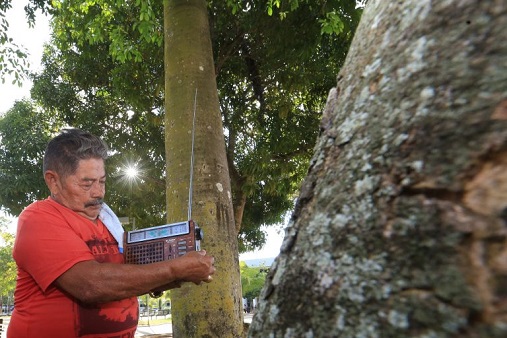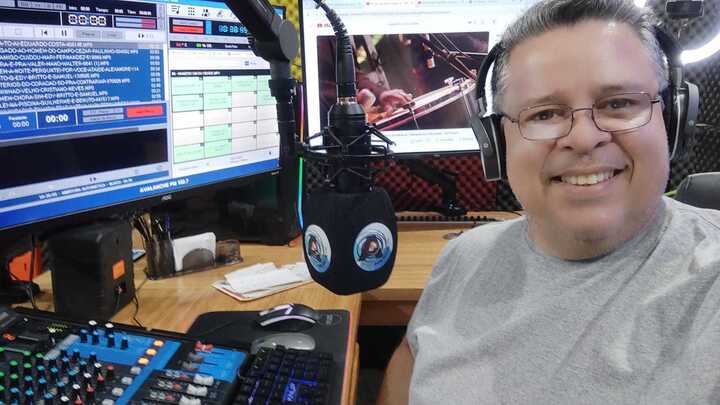On an agricultural settlement near the Amazon and Arapiuns rivers, a radio station run by young locals broadcasts news to residents through loudspeakers and low-power transmitters. In Boa Vista, near Brazil’s borders with Venezuela and Guyana, a Catholic radio station dedicates much of its programming to Indigenous rights and the environment. In Sena Madureira, near the borders with Bolivia and Peru, an independent journalist strives to broadcast information that challenges powerful local interests.
These are some of the initiatives featured on the Living Media Map of the Amazon, a project that identifies local and regional media in the Brazilian Amazon that cover social issues and the environment. Launched in 2022 by the Brazilian news outlet InfoAmazonia, the map was last updated last month, adding radio stations that cover social and environmental issues in the region but lack websites. There are 307 outlets on the map, and 49 are radio stations distributed across 38 towns.
Often, these radio stations reach communities of only hundreds of people. However, in a region with vast distances, challenging transport and where stories are often told by outsiders rather than locals, their importance cannot be underestimated, journalist Guilherme Guerreiro Neto, a researcher on the mapping project, told LatAm Journalism Review (LJR).
“Radio in the Amazon has always been very relevant because of its ability to bridge great distances,” Guerreiro Neto said. “Today, community radio stations not only bring messages to distant places but also produce content and give voice to the local community, allowing it to be heard. These radio stations play an essential role in circulating local information.”

Man listens to the radio in Acre (Photo: Marcos Vicentti/Agência de Notícias do Acre)
One of these stations is Rádio Web Uxicará—a name that combines the names of two local fruits, uixi and cará—which broadcasts an hour of programming daily from Monday to Friday and two hours daily on weekends in the Vila Brasil community, part of the Gleba Grande agro-extractive settlement, where 6,600 families live on the banks of the Arapiuns River, in the town of Santarém in the state of Pará.
The station launched in 2010, initially as an improvised setup in a speaker box on top of a telephone tower. Even today, broadcasts within the community are still done through two loudspeakers. In August of last year, with support from the NGO Projeto Saúde e Alegria, the station opened a studio and has plans to broadcast online.
The programming is diverse, Aldeci Dias, one of the station's hosts, told LJR. There are religious programs, community announcements and programs covering socio-environmental topics. The community faces impacts from mining, as well as climate change effects like drought, Dias noted.
“The community is suffering a lot from drought, with rivers drying up. The trend is worsening every year,” he said. “The radio is essential for organizing the community and helping defend the territory.”
The radio station collaborates with local schools and often brings students on-air to debate, Dias added. “These debates help train future journalists and encourage young people to become community leaders. They come on, debate, and lose their shyness,” he said.

Launch of Uxicará web radio in the Vila Brasil community, part of the Gleba Grande agro-extractive settlement, where 6,600 families live along the banks of the Arapiuns River in Santarém, Pará (Photo: Júnior Albuquerque/Courtesy of Projeto Saúde e Alegria)
One major challenge in producing the map was differentiating between outlets that cover social and environmental issues and those that defend agribusiness, explained Helena Berto, coordinator of InfoAmazonia's Rede Cidadã project, which oversees the map.
Many outlets are funded by business people or politicians linked to the rural sector and prioritize market aspects, Berto said. The state of Mato Grosso has the strongest agribusiness presence: according to the map, 51% of media outlets there have dedicated sections for agribusiness topics.
In the nine states of the Amazon region, nearly 17% of outlets have agribusiness-focused sections, while 20% have socio-environmental editorial sections, according to the map.
“Agribusiness coverage focuses on the interests of those linked to agribusiness and lacks a critical view of climate and environmental issues,” Berto said. “Coverage of how the agribusiness market is doing is far removed from environmental concerns.”
To produce the map, the InfoAmazonia team consulted the Atlas da Notícia, databases, communication experts and local associations. The project identified surprising cases, such as Rádio Monte Roraima in Boa Vista. The station is part of the José Allamano Foundation, created by the Roraima Catholic diocese in the early 2000s for educational purposes.
“It was a time of significant conflicts between Indigenous people and landowners in Roraima, with land demarcation disputes,” Father Luiz Claudemir Botteon, the station's director, told LJR. “There was a public radio station and two stations covering political issues, but none defended Indigenous peoples. This radio station was created to be the voice of Indigenous peoples.”
With a reach of about 62 miles and online broadcasts, as well as a website updated daily continuous, the station has 12 hours of original programming daily. This includes two daily news bulletins and programs targeting specific audiences, such as the Indigenous population and migrants arriving from Venezuela. Other programs are made in partnership with public agencies like the Public Defender's Office and the Public Prosecutor's Office.
News and reports written by the station's journalists also feed the Vatican's news agency, Father Botteon noted. Although it is a Catholic station and covers religious themes, this is not its primary focus, he said. “We mention religious topics, but it is not a religious-themed station. We respect the Church's social doctrine,” he said.
The map includes media with different profiles, from those covering local news to those conducting in-depth and investigative reporting, including larger organizations that cover socio-environmental issues in their newscasts.
InfoAmazonia's Rede Cidadã includes other initiatives, such as a mentoring network. This year, five outlets were selected for a support program, receiving editorial and institutional assistance, along with incentives to collaborate on content production.
Financial sustainability is a constant challenge for most outlets, with limited resources and a lack of government support. One broadcaster who struggles to stay afloat is Dirley Oliveira, better known as Sorriso, who hosts a program on Rádio Avalanche FM in Sena Madureira, state of Acre, and is the director of the Yaco News site, where six journalists work.
He told LJR that as an independent journalist, he faces retaliation. “When you criticize a politician, merchants are pressured to pull ads to try to weaken us. Without this support, we can’t survive,” Oliveira said. “Doing independent journalism in a small town is very hard.”
Oliveira says he faces political pressure as well as pressure from religious groups and large landowners. “Rural producers don’t like the work we do,” he said. “The more pasture, the more cattle. Large landowners are interested in clearing everything, deforesting everything, and it's the small producers and riverine people who suffer.”

Dirley Oliveira, also known as Sorriso, in the radio studio of Avalanche FM in Sena Madureira, Acre, Brazil (Photo: Courtesy of Yaco News)
These outlets also struggle to cover production costs for reports and investigations. Producing content may require long trips by boat or car and considerable resources.
One goal of Rede Cidadã is to facilitate collaborations and information exchange among outlets. Next year, they also hope smaller outlets can collaboratively cover international events relevant to Amazon communities, like the UN Climate Conference.
Updates to the map are planned. “We call it a living map,” Guerreiro Neto said. “It's always open to new stations. It can be constantly updated.”